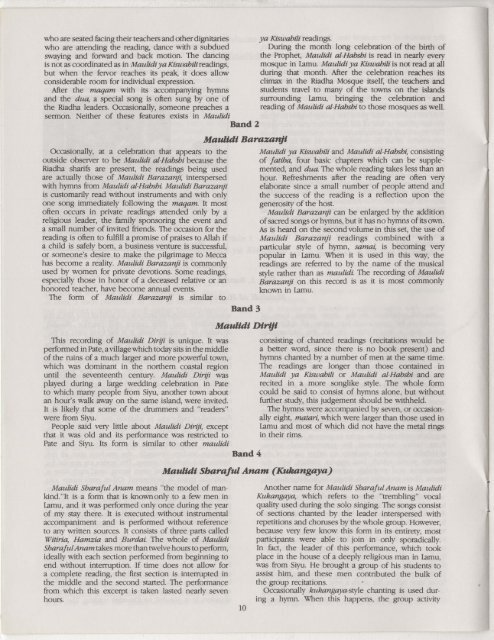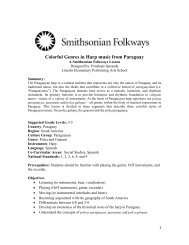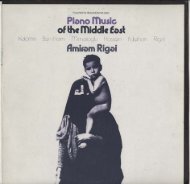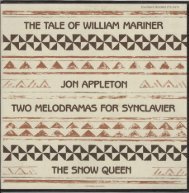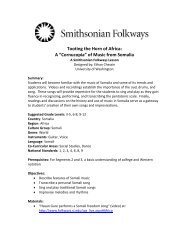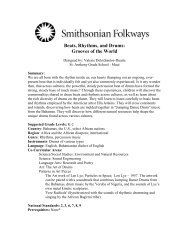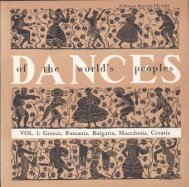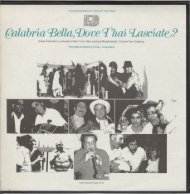You also want an ePaper? Increase the reach of your titles
YUMPU automatically turns print PDFs into web optimized ePapers that Google loves.
who are seated facing <strong>the</strong>ir teachers and o<strong>the</strong>r dignitarieswho are attending <strong>the</strong> reading, dance with a subduedswaying and forward and back motion. The dancingis not as coordinated as in Maulidi ya Kiswahili readings,but when <strong>the</strong> fervor reaches its peak, it does allowconsiderable room for individual expression.After <strong>the</strong> maqam with its accompanying hymnsand <strong>the</strong> dua, a special song is <strong>of</strong>ten sung by one <strong>of</strong><strong>the</strong> Riadha leaders. Occasionally, someone preaches asermon. Nei<strong>the</strong>r <strong>of</strong> <strong>the</strong>se features exists in MaulidiOccasionally, at a celebration that appears to <strong>the</strong>outside observer to be Maulidi al-Habshi because <strong>the</strong>Riadha sharifs are present, <strong>the</strong> readings being usedare actually those <strong>of</strong> Maulidi Barazanji, interspersedwith hymns from Maulidi al-Habshi. Maulidi Barazanjiis customarily read without instruments and with onlyone song immediately following <strong>the</strong> maqam. It most<strong>of</strong>ten occurs in private readings attended only by areligiOUS leader, <strong>the</strong> family sponsoring <strong>the</strong> event anda small number <strong>of</strong> invited friends. The occasion for <strong>the</strong>reading is <strong>of</strong>ten to fulfill a promise <strong>of</strong> praises to Allah ifa child is safely born, a business venture is successful,or someone's desire to make <strong>the</strong> pilgrimage to Meccahas become a reality. Maulidi Barazanji is commonlyused by women for private devotions. Some readings,especially those in honor <strong>of</strong> a deceased relative or anhonored teacher, have become annual events.The form <strong>of</strong> Maulidi Barazanji is similar toThis recording <strong>of</strong> Maulidi Diriji is unique. It wasperformed in Pate, a village which today sits in <strong>the</strong> middle<strong>of</strong> <strong>the</strong> ruins <strong>of</strong> a much larger and more powerful town,which was dominant in <strong>the</strong> nor<strong>the</strong>rn coastal regionuntil <strong>the</strong> seventeenth century. Maulidi Diriji wasplayed during a large wedding celebration in Pateto which many people from Siyu, ano<strong>the</strong>r town aboutan hour's walk away on <strong>the</strong> same island, were invited.It is likely that some <strong>of</strong> <strong>the</strong> drummers and "readers"were from Siyu.People said very little about Maulidi Dinji, exceptthat it was old and its performance was restricted toPate and Siyu. Its form is similar to o<strong>the</strong>r maulidiBand 2Maulldi BarazanjiBand 3Maulldi DlrljiBand 4Maulldi Sharaful Anam (Kukangaya)ya Kiswahili readings.During <strong>the</strong> month long celebration <strong>of</strong> <strong>the</strong> birth <strong>of</strong><strong>the</strong> Prophet, Maulidi al-Habshi is read in nearly everymosque in ramu. Maulidi ya Kiswahili is not read at allduring that month. After <strong>the</strong> celebration reaches itsclimax in <strong>the</strong> Riadha Mosque itself, <strong>the</strong> teachers andstudents travel to many <strong>of</strong> <strong>the</strong> towns on <strong>the</strong> islandssurrounding ramu, bringing <strong>the</strong> celebration andreading <strong>of</strong> Maulidi al-Habshi to those mosques as well.Maulidi ya Kiswahili and Maulidi al-Habshi, consisting<strong>of</strong> jatiha, four basic chapters which can be supplemented,and dua. The whole reading takes less than anhour. Refreshments after <strong>the</strong> reading are <strong>of</strong>ten veryelaborate since a small number <strong>of</strong> people attend and<strong>the</strong> success <strong>of</strong> <strong>the</strong> reading is a reflection upon <strong>the</strong>generosity <strong>of</strong> <strong>the</strong> host.Maulidi Barazanji can be enlarged by <strong>the</strong> addition<strong>of</strong> sacred songs or hymns, but it has no hymns <strong>of</strong> its own.As is heard on <strong>the</strong> second volume in this set, <strong>the</strong> use <strong>of</strong>Maulidi Barazanji readings combined with aparticular style <strong>of</strong> hymn, samai, is becoming verypopular in ramu. When it is used in this way, <strong>the</strong>readings are referred to by <strong>the</strong> name <strong>of</strong> <strong>the</strong> musicalstyle ra<strong>the</strong>r than as maulidi. The recording <strong>of</strong> MaulidiBarazanji on this record is as it is most commonlyknown in ramu.consisting <strong>of</strong> chanted readings (recitations would bea better word, since <strong>the</strong>re is no book present) andhymns chanted by a number <strong>of</strong> men at <strong>the</strong> same time.The readings are longer than those contained inMaulidi ya Kiswahili or Maulidi al-Habshi and arerecited in a more songlike style. The whole formcould be said to consist <strong>of</strong> hymns alone, but withoutfur<strong>the</strong>r study, this judgement should be withheld.The hymns were accompanied by seven, or occasionallyeight, matan, which were larger than those used inramu and most <strong>of</strong> which did not have <strong>the</strong> metal ringsin <strong>the</strong>ir rims.Maulidi Sharajul Anam means "<strong>the</strong> model <strong>of</strong> mankind."It is a form that is known only to a few men inramu, and it was performed only once during <strong>the</strong> year<strong>of</strong> my stay <strong>the</strong>re. It is executed without instrumentalaccompaniment and is performed without referenceto any written sources. It consists <strong>of</strong> three parts calledWitina, Hamzia and Burdai. The whole <strong>of</strong> MaulidiSharajulAnam takes more than twelve hours to perform,ideally with each section performed from beginning toend without interruption. If time does not allow fora complete reading, <strong>the</strong> first section is interrupted in<strong>the</strong> middle and <strong>the</strong> second started. The performancefrom which this excerpt is taken lasted nearly sevenhours.10Ano<strong>the</strong>r name for Maulidi Sharajul Anam is MaulidiKukangaya, which refers to <strong>the</strong> "trembling" vocalquality used during <strong>the</strong> solo singing. The songs consist<strong>of</strong> sections chanted by <strong>the</strong> leader interspersed withrepetitions and choruses by <strong>the</strong> whole group. However,because very few know this form in its entirety, mostparticipants were able to join in only sporadically.In fact, <strong>the</strong> leader <strong>of</strong> this performance, which tookplace in <strong>the</strong> house <strong>of</strong> a deeply religiOUS man in ramu,was from Siyu. He brought a group <strong>of</strong> his students toassist him, and <strong>the</strong>se men contributed <strong>the</strong> bulk <strong>of</strong><strong>the</strong> group recitations.Occasionally kukangaya-style chanting is used duringa hymn. When this happens, <strong>the</strong> group activity


